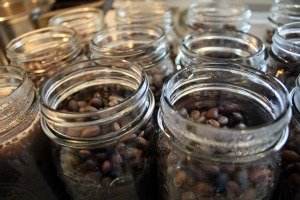
 2
2












 1
1




"You must be the change you want to see in the world." "First they ignore you, then they laugh at you, then they fight you, then you win." --Mahatma Gandhi
"Preach the Gospel always, and if necessary, use words." --Francis of Assisi.
"Family farms work when the whole family works the farm." -- Adam Klaus

 4
4



















 2
2




Best luck: satisfaction
Greatest curse, greed

 2
2




Hans Albert Quistorff, LMT projects on permies Hans Massage Qberry Farm magnet therapy gmail hquistorff
 1
1




 2
2




 1
1




Best luck: satisfaction
Greatest curse, greed















Dottie Kinn
www.DottieKinn.com




Dottie Kinn wrote:I've canned both dried beans and dried peas.
Here's my method: SOAK BEANS OVERNIGHT in filtered or well water!! Rinse with clean cold water (these steps help reduce gas). Fill canning jars half full or slightly less of soaked beans then fill with boiling water leaving 1" headspace. Process 40 minutes for a quart or 30 minutes for a pint.
General notes about pressure canning, I NEVER add salt--it doesn't matter what the recipe says--for your health's sake, skip it. Use herbs instead for flavor. If you want more salt flavor, add it to the food on the plate you're about to eat.
Best luck: satisfaction
Greatest curse, greed








 ). Sometimes I just cut a round slab that perfectly fits the jar, sometimes chunks and press out the air pockets. Don't make it too tight, though. I cracked several jars doing that. Leave the 1" at top. NO WATER, SALT, OR OTHER LIQUID. Process 12 pounds for 70 minutes. 95 minutes for quarts. The meat makes it's own juice. We've been doing this 2 years and no problems. The meat is absolutely delicious, moist, and tender.
). Sometimes I just cut a round slab that perfectly fits the jar, sometimes chunks and press out the air pockets. Don't make it too tight, though. I cracked several jars doing that. Leave the 1" at top. NO WATER, SALT, OR OTHER LIQUID. Process 12 pounds for 70 minutes. 95 minutes for quarts. The meat makes it's own juice. We've been doing this 2 years and no problems. The meat is absolutely delicious, moist, and tender. 
Dottie Kinn
www.DottieKinn.com





Dottie Kinn
www.DottieKinn.com




Best luck: satisfaction
Greatest curse, greed
 3
3




Pecan Media: food forestry and forest garden ebooks
Now available: The Native Persimmon (centennial edition)
 3
3




 1
1




Scott Perkins wrote:My recommendation is that you immediately get a smallish spiral bound notebook and log every thing you do regarding ingredients used and precise amounts and cooking times/cooling method etc. You will definitely find that different beans require different cooking times along with different grains etc.
Scott Perkins wrote:Again BROWN RICE is the best to cook because it takes the longest.
Scott Perkins wrote:Cracked corn ( as in animal feed) works pretty good... Cornmeal is too fine and results in polenta or grits which may be what you want.
Scott Perkins wrote:Lastly as you are finding that pressure cooking/canning neuters the spices... I would have you consider adding the spices to flavor after cooking. That is not that hard to sprinkle black pepper, salt, garlic or onion powder etc just prior to eating.
Scott Perkins wrote:Lastly... dont forget MEAT. Raw Ham or pork or BACON or chicken breast chunks added to your dry beans and grains impart great flavor and variety to your dish.
Scott Perkins wrote:The 2nd "last" thing as you are seeing is that you are finishing up with a LOT of air in the jars after processing.... This is due to the beans and grains soaking up the water. Fill the jars to absolutely overflowing with water and you will still have an inch of air or more after processing in the jar.
Scott Perkins wrote:I have let others taste my handiwork and I have a good buddy who swears my beans were the best ever and that particular batch was flavored with pickle juice poured out of a dill pickle jar.
That added a little garlic taste but mostly it was the vinegar I think that gave the beans a great taste.
Pecan Media: food forestry and forest garden ebooks
Now available: The Native Persimmon (centennial edition)




 2
2




Pecan Media: food forestry and forest garden ebooks
Now available: The Native Persimmon (centennial edition)
 1
1




Gail Gardner @GrowMap
Small Business Marketing Strategist, lived on an organic farm in SE Oklahoma, but moved where I can plant more trees.
 1
1




Dan Boone wrote:Pease porridge hot, pease porridge cold, pease porridge in the pot, nine days old.
Gail Gardner @GrowMap
Small Business Marketing Strategist, lived on an organic farm in SE Oklahoma, but moved where I can plant more trees.
 3
3




Pecan Media: food forestry and forest garden ebooks
Now available: The Native Persimmon (centennial edition)
 1
1




Pecan Media: food forestry and forest garden ebooks
Now available: The Native Persimmon (centennial edition)








At my age, Happy Hour is a nap.
 2
2




Best luck: satisfaction
Greatest curse, greed

|
You don't like waffles? Well, do you like this tiny ad?
rocket mass heater risers: materials and design eBook
https://permies.com/w/risers-ebook
|








